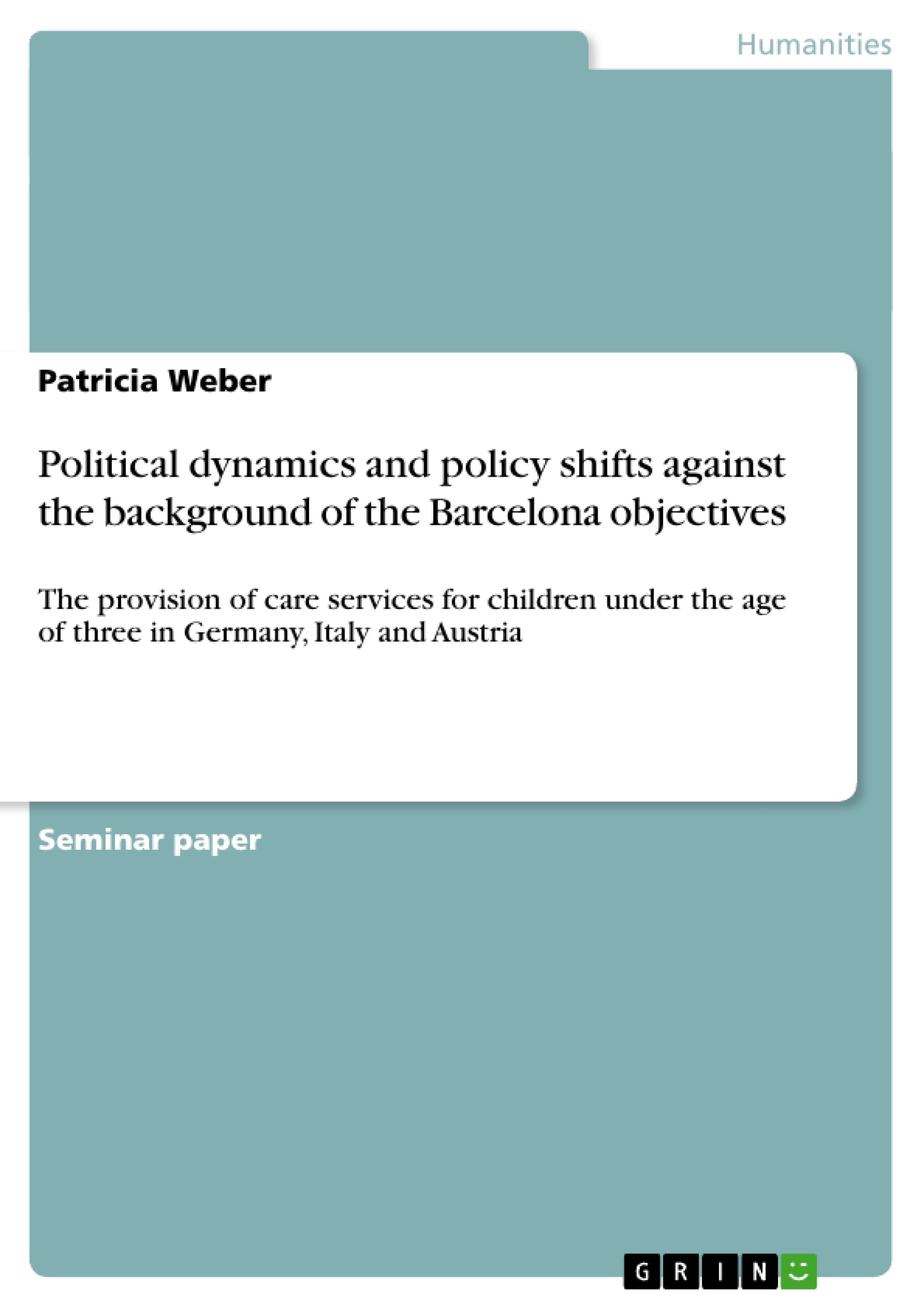In March 2002 the Barcelona convention took the initiative to „remove disincentives to female labour force participation and strive, taking into account the demand for childcare facilities and in line with national patterns of provision, to provide childcare by 2010 to at least 90% of children between 3 years old and the mandatory school age and at least 33% of children under 3 years of age“ (EU Com 2008) The expansion of child care facilities are intended to increase parents‘ labor market participation, especially of women, and thus help to encourage gender equality. These Barcelona objectives were an integral part of the European Strategy for Growth and Employment (ibidem). In fact, female labour participation constantly increased during the last few years. Many European countries already show high enrollment rates for pre-school-aged children. But the supply of child care provision for under the age of three is in many European member states still underdeveloped (Esping-Anderson 2011: 126). This paper documents which initiatives and measures were taken to develop the child care facilities in three European countries: Austria, Italy and Germany as examples for a conservative welfare state (Esping-Anderson 1990) will be analyzed in comparative case studies. All three countries share an emphasis on the centrality of the family in targeting material needs and approving an institutional gendered division of paid and domestic work (Esping-Anderson 1999: 83). The focus of this work will be on the first age group of the Barcelona objectives, those under age three. The aim of the present paper is to find out explanatory factors for the still existent gap between demand and supply of child care provision for those under age three by considering nationally implemented laws and regulations as well as labor market developments and cultural preferences in all three countries. Finally, the question should therefore be asked: why Austria, Italy and Germany did not meet the Barcelona objectives to achieve at least a coverage rate of 33% of child care facilities for children under 3 years old?
The following section gives a short descriptive overview of recent family policies in Austria, Germany and Italy in reference to the realization of the Barcelona objectives.
Inhaltsverzeichnis (Table of Contents)
- Introduction
- Germany: Piecewise expansion of the childcare infrastructure
- Continuing regional diversity in public childcare
- Italy: Almost frozen family policies: A challenge for Italian women
- High pre-school child care provision, but low female employment
- Regional pioneers within national established gender roles
- Austria: “Policy-mix” and enduring traces of the “Black-Blue-Government”
- High female- part-time rates and poor supply of child care services for under three
- Expansion of central and regional public investment in childcare
- Common challenges and barriers to achieve the Barcelona Objectives
Zielsetzung und Themenschwerpunkte (Objectives and Key Themes)
This paper examines the expansion of child care facilities in Austria, Italy, and Germany, analyzing the initiatives and measures taken in these countries to meet the Barcelona Objectives for child care provision. The paper focuses on the first age group of the Barcelona objectives, children under the age of three, specifically exploring why these countries have not achieved the 33% coverage rate for this age group. The analysis considers factors such as national laws and regulations, labor market developments, and cultural preferences.- The implementation of the Barcelona Objectives for child care provision in Austria, Italy, and Germany.
- The impact of national policies and regulations on child care provision.
- The role of cultural preferences and labor market developments in shaping child care provision.
- The challenges and barriers faced in achieving the Barcelona Objectives for children under the age of three.
- The potential implications for supporting the achievement of the Barcelona Objectives in these countries.
Zusammenfassung der Kapitel (Chapter Summaries)
- Introduction: This chapter introduces the Barcelona Objectives and the paper's research focus on the lack of child care provision for children under three years old in Austria, Italy, and Germany. It highlights the significant differences in childcare coverage between the three countries, despite their similar social welfare systems and male breadwinner models.
- Germany: Piecewise expansion of the childcare infrastructure: This chapter details the historical evolution of child care policies in Germany, outlining the shift from a traditional male breadwinner model to a more dual-earner model. It discusses the slow development of childcare facilities and the influence of regional disparities in childcare provision. The chapter also examines the recent federal government initiatives to improve childcare access, particularly for children under three, including the introduction of the Federal Daycare Expansion Act and the Child Promotion Act.
- Continuing regional diversity in public childcare: This chapter delves deeper into the regional disparities in childcare provision in Germany, comparing the historical differences between East and West Germany. The chapter explains the legacy of socialist childcare policies in East Germany and the subsequent impact of unification, which imposed a more decentralized system of childcare provision.
Schlüsselwörter (Keywords)
The main keywords and focus topics of this paper are: childcare provision, Barcelona Objectives, child care facilities, family policies, gender equality, labor market participation, welfare state, cultural preferences, regional disparities, Austria, Italy, Germany, conservative welfare state, male breadwinner model.- Quote paper
- Patricia Weber (Author), 2013, Political dynamics and policy shifts against the background of the Barcelona objectives, Munich, GRIN Verlag, https://www.grin.com/document/267927



